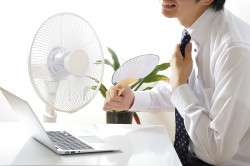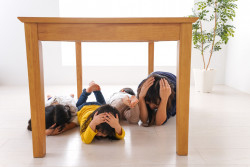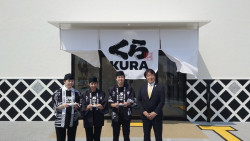
Originally published on metropolis.co.jp on April 2011
 So, tell us a bit about your background.
So, tell us a bit about your background.
My main job is as a member of the Minato Ward Assembly, which keeps me involved in many projects, such as coming up with ways to support our growing elderly population. As a resident of Ark Hills, I serve as the head of the Ark Hills Neighborhood Association. I’m also an ujiko—sort of a representative for the parishioners—for our local shrine, Hikawa Jinja; and I’m actively involved in the Azabu Elementary School Area Disaster Prevention Council.
Wow, you’re very busy.
Yes. And with the exception of my Minato-ku position, all of my other work is on a volunteer basis. My wife is always… you know. [He laughs, making his fingers into horns.]
Speaking of disaster prevention, what did you think of how the March 11 earthquake was handled?
While this earthquake was a terrible tragedy for the people living in Tohoku, here in Tokyo we must use it as an example. Even though Tokyo escaped damage, there was a huge effect on the city’s infrastructure. No one expected it to be so bad. Minato-ku has approximately 99,434 households; of those, 86.7% live in multi-unit apartment buildings. In one sense, that’s safer. But the problem is what happens if the power goes out. During an earthquake, the elevators stop automatically. To get them moving again, a representative from the manufacturer has to come and inspect it for damage, but with so many buildings, this takes a long time. Residents who live on the 20th floor might not be able to get back to their homes—especially the elderly. The water supply is typically kept in a large tank on the roof, so if the power goes out there’s no water. And of course there’s no heat or A/C—which is a huge problem because in many of these high-rises, the windows don’t open. In summer it would be unbearable.
Minato-ku is also one of the city’s busiest business districts. What impact does this have?
There are about 200,000 people living in Minato; but an additional 900,000 or so come in to the area to work. We have to consider what to do for them in the event of another disaster. Since this recent quake happened on a Friday, most people were trying to get home right away. But in reality, that’s how you get secondary injuries, from people trying to enter damaged buildings.
What should people do in the event of a disaster?
You can always ask for help at a school. They’ll let you use the restrooms, telephones… If it comes down to it, you can also spend the night there. That’s the kind of information we need to make sure people are aware of. During this quake, I was surprised by how many people showed up at the Azabu Elementary School [one of Minato-ku’s shelters].We had a lot of foreigners, couples, people bringing pets… It really impressed upon me how much we need to do, in terms of preparation and planning, for the next time. We need people in the shelters who speak foreign languages, to help interpret. And we need interviews like this to raise awareness among foreigners of what to do in the event of an earthquake.
How do you think Japan will cope in the aftermath?
We live in a country with lots of earthquakes and tsunamis, but I believe that the Japanese people are blessed with the ability to endure such disasters and come back stronger. An earthquake is like a war with nature. We have armies to fight it—the SDF, police, firefighters… And just like a war, it’s going to take many years and trillions of yen to return the country back to what it was before. In the end, there will probably be close to 20,000 casualties. Most of the people who are still missing are probably beyond saving at this point. But I believe that we will keep searching until the last person is found. And I feel grateful to live in such a country.
For more info see http://mizunomunehiro.com.







